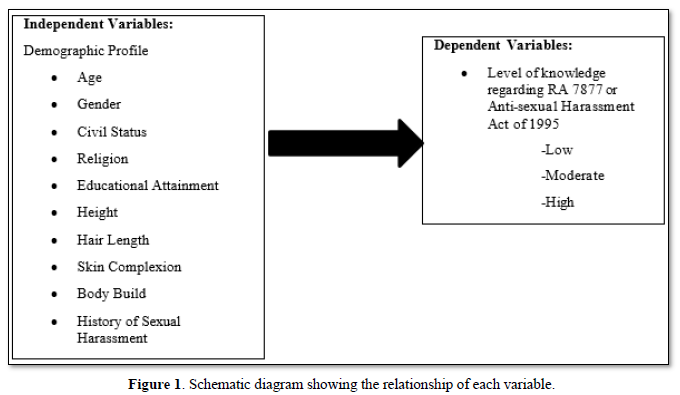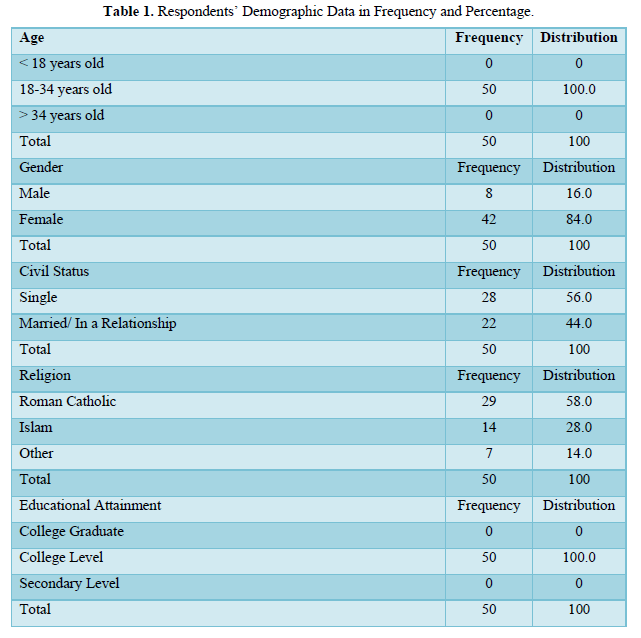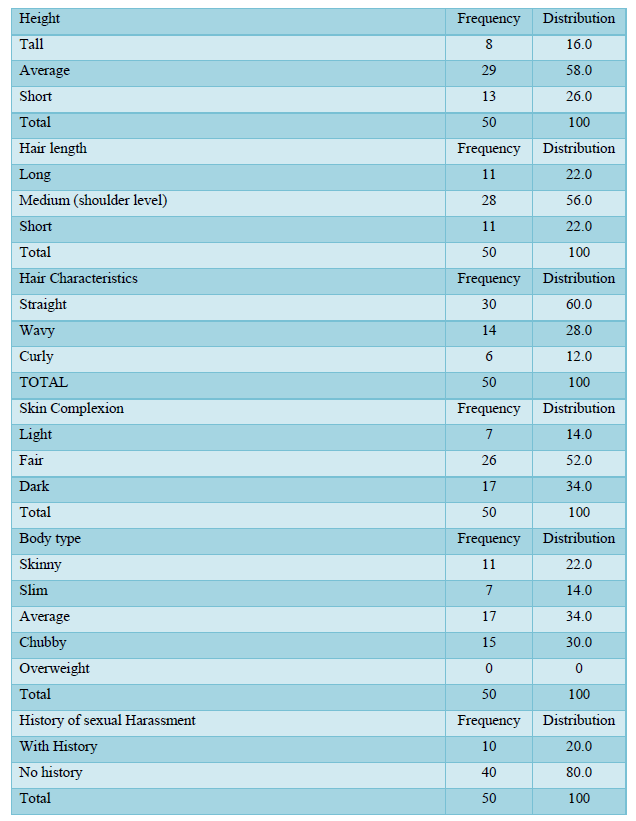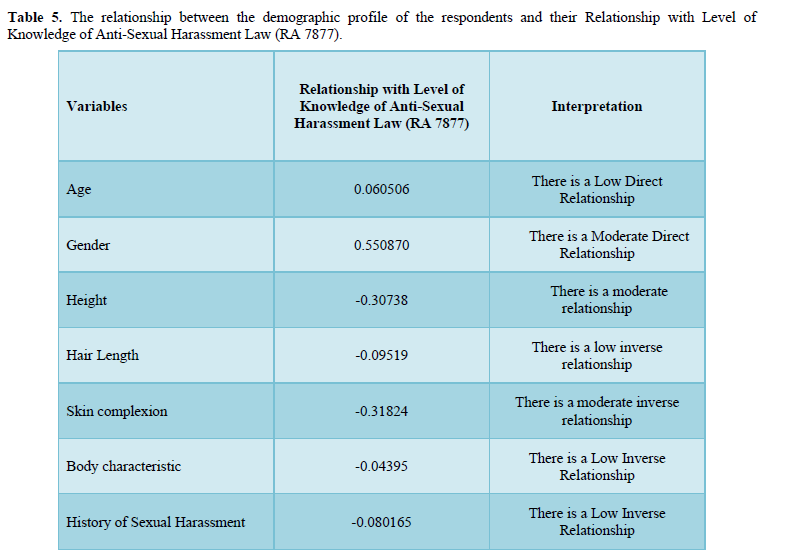Research Article
On Sexual Harassment: Knowledge and Risk Among Grade-10 Students, Mindanao State University-Iligan Institute of Technology Senior Nursing Students, and Staff Nurses of Selected Hospitals in Iligan City, Philippines
14311
Views & Citations13311
Likes & Shares
Every year, millions of women and girls worldwide suffer violence, be it domestic violence, rape, female genital mutilation/cutting, dowry-related killing, trafficking, sexual violence in conflict-related situations and other manifestation of violence [1]. A law, RA 7877, also known as “Anti-sexual Harassment of 1995” is considered a landmark of legislation in the Philippines to address and prevent incidence of sexual harassment in schools and workplace. This research utilized the descriptive-correlational-comparative research design to determine the level of knowledge of the fifty respondents from Mindanao State University - Iligan Institute of Technology (MSU-IIT) Senior Nursing Students in Iligan City regarding sexual harassment. Random sampling method was used to gather data. The research instrument used is a modified standardized questionnaire form Civil Service Commission’s Disciplinary Rules on Sexual Harassment Cases. It was reviewed by nurse- lawyers. The result showed majority of the respondents has low to moderate level of knowledge (≤67th percentile) of RA 7877 (anti-sexual harassment law); using Pearson, result shows a low direct relationship between the respondents’ knowledge with RA 7877 and their Age (r: 0.060506); there is a moderate direct relationship between respondent's knowledge with RA 7877 and their Gender (r: 0.550870); there is significant relationship between respondents’ Civil Status and their level of knowledge (r: 0.103), indicating that respondents who are in a dating relationship/married have lower level of knowledge compared to respondents who are single. Hair length, body characteristic, and history of sexual harassment have low inverse relationship with their level of knowledge of RA 7877. Skin complexion has a moderate inverse relationship with their level of knowledge of RA 7877. This finding, analyzed in light with test results show that majority of the respondents has a low to moderate level of knowledge (below 67th percentile), highlights the need for academic institutions as well as work institutions like hospitals to enhance focus on education, review, update, and implementation on RA 7877 to mitigate, if not eliminate, the blight of sexual harassment.
Keywords: Sexual harassment, Prevention, Demographic profile, Knowledge
INTRODUCTION
Every year, millions of women and girls worldwide suffer violence, be it domestic violence, rape, female genital mutilation/cutting, dowry-related killing, trafficking, sexual violence in conflict-related situations and other manifestation of violence [1,2]. In 2006, the Equal Opportunity Committee of the United States noted a drastic increase of 100 percent in sexual harassment cases. A survey in United States indicates that 1 in every 3 women between ages 18-34 experienced sexual harassment at work [3]. In The 2012 National Harassment Survey in Australia, one in four women (25%) is sexually harassed in the workplace [4]. Although, sexual harassment is a universal issue, it is problematic in situations where women are being viewed culturally “as less able” and where the workforce comprises largely of young women with little work experience [5]. A study of harassment complaints, 37% of the harasser is an immediate or higher-level superior supervisor, 95% of the time is man, older than the victim (68%), and a co-worker (65%). The victims are usually women although men (usually gay) sometimes become victims of harassment. They are usually young
woman between the ages of 16 and 19 (67%); those 55 years and older had a 22% incidence rate. Victimized also are trainees with no job security and women in non-traditional jobs working with male supervisors [6]. For this reason, the researchers aim to conduct an investigation to determine the level of knowledge on Sexual Harassment (RA 7877), health care providers particularly nurses on case on Knowledge and Risk, in an attempt to help the Philippine government in its goals to prevent and reduce the increasing case of this crimes. The researchers are hoping that through the results of this study, individuals in the workplace or school will have awareness. The Philippines implemented the Republic Act 7877 or the Anti-Sexual Harassment Act of 1995 and became a landmark special legislation that names, defines, and penalizes the crime of sexual harassment in workplaces and educational or training institutions in the public and private sectors. The law states that “work, education or training-related sexual harassment is committed by an employer, employee, manager, supervisor, agent of the employer, teacher, instructor, professor, coach, trainer, or any other person who, having authority, influence or moral ascendancy over another in a work or training or education environment, demands, requests or otherwise requires any sexual favor from the other, regardless of whether the demand, request or requirement for submission is accepted by the object of said act. Specifically, in a work-related or employment environment, sexual harassment is committed when:
- The sexual favor is made as a condition in the hiring or in the employment, re-employment or continued employment of said individual, or in granting said individual favorable compensation, terms of conditions, promotions, or privileges; or the refusal to grant the sexual favor results in limiting, segregating or classifying the employee which in any way would discriminate, deprive or diminish employment opportunities or otherwise adversely affect said employee;
- The above acts would impair the employee’s rights or privileges under existing labor laws; or
- The above acts would result in an intimidating, hostile, or offensive environment for the employee [7].
On the other hand, in an education or training environment, sexual harassment is committed:
- Against one who is under the care, custody or supervision of the offender;
- Against one whose education, training, apprenticeship or tutorship is entrusted to the offender;
- When the sexual favor is made a condition to the giving of a passing grade, or the granting of honors and scholarships, or the payment of a stipend, allowance or other benefits, privileges, or consideration; or
- When the sexual advances result in an intimidating, hostile or offensive environment for the student, trainee or apprentice [7].
In Domingo vs. Rayala, a case involving a stenographer as the victim and the NLRC Chairman as the perpetrator, the Supreme Court enunciated that sexual harassment is an imposition of misplaced “superiority” which is enough to dampen an employee’s spirit and her capacity for advancement. It affects her sense of judgment; it changes her life. Thus, in holding and squeezing the victim’s shoulders, running his fingers across her neck and tickling her ear, having inappropriate conversations with her, giving her money allegedly for school expenses with a promise of future privileges, and making statements with unmistakable sexual overtones - all resound with deafening clarity the unspoken request for a sexual favor [8]. R.A 7877 mandates every employer to take all reasonable steps to prevent sexual harassment in the workplace. This means that employers must actively implement precautionary measures to minimize the risk of sexual harassment occurring and to respond appropriately when harassment does occur. Furthermore, employers are held liable in damages resulting from sexual harassment committed during the employment. As specifically stated under R.A 7877,
Section 4. Duty of the Employer or Head of Office in a Work-related, Education or Training Environment. - It shall be the duty of the employer or the head of the work-related, educational or training environment or institution, to prevent or deter the commission of acts of sexual harassment and to provide the procedures for the resolution, settlement or prosecution of acts of sexual harassment. Towards this end, the employer or head of office shall: Promulgate appropriate rules and regulations in consultation with and joint1y approved by the employees or students or trainees, through their duly designated representatives, prescribing the procedure for the investigation of sexual harassment cases and the administrative sanctions therefore [9].
Section 5. Liability of the Employer, Head of Office, Educational or Training Institution. - The employer or head of office, educational or training institution shall be solidarity liable for damages arising from the acts of sexual harassment committed in the employment, education or training environment if the employer or head of office, educational or training institution is informed of such acts by the offended party and no immediate action is taken [9]. Although, there has been laws passed to address and prevent sexual harassment still sexual harassment in the workplace is high [10-11]. Employees are still subjected to unsafe work environment and majority is not aware of any sexual harassment policies in their workplace [11]. In the Philippines, there were 757 recorded cases of sexual harassment or five (5) cases per month and one child becomes a victim of sexual harassment every seven hours [12]. The highest incidence of sexual harassment is among women who are divorced/separated/widowed (36.5%), followed by women who are married or living together with their partner (22.3%); while single women who never married had the lowest incidence (11.3%) [12].
Theoretical Framework
In Hildegard Peplau’s Theory of Interpersonal Relations it explains that the purpose of nursing is to establish interpersonal relationship to people and help them when they felt difficulties. Both the nurse and the patient interact so that the health care services will be successful and achieve the same goal. This theory helps us in our research so that we have basis in doing our responsibility and establish interpersonal relationship, which is the integral part of doing the research.
Conceptual Framework
This conceptual model is used in this study to guide the researchers in the identification and designation of concepts as dependent variables and independent variables. The interplay of these variables is shown in this model.
The diagram in Figure 1 shows the independent variables, these are age, gender, civil status, religion, educational attainment, height, hair length, skin complexion, body build, history of sexual harassment. The level of knowledge of senior nursing students regarding RA 7877 or Anti-sexual Harassment Act of 1995. These factors are significant in determining the respondents’ current level of knowledge of sexual harassment.

METHODS
The study used a descriptive-correlational comparative research design which is undertaken for practical purposes; in this case assess the level of knowledge of the respondents. The design is use to described the demographic profile of the respondents, to correlate the respondent’s demographic profile with the respondent’s level of knowledge about RA 7877. The identified independent variable for this study is the demographic profile of fifty (50) Mindanao State University – Iligan Institute of Technology senior nursing students. The dependent variable for this study is the level of knowledge of Mindanao State University – Iligan Institute of Technology senior nursing students which will be evaluated through a test using a modified standardized questionnaire. The respondents of this study are from Mindanao State University – Iligan Institute of Technology senior nursing students which will be selected through random sampling method. This sampling method is a type of non-probability sampling where the researcher consciously selects particular elements or subjects for addition in a study so as to make sure that the elements will have certain characteristics pertinent to the study. The researchers will get a sample size of fifty (50) Mindanao State University – Iligan Institute of Technology senior nursing students which will be the primary respondents in the research. This study took place Mindanao State University – Iligan Institute of Technology in Iligan City, Lanao del Norte which is located in Northern area of Mindanao. The researchers selected Iligan City because of its convenient accessibility and proximity to the researchers. The respondents of the study are fifty (50) Mindanao State University – Iligan Institute of Technology senior nursing students identified through random sampling. Respondent maybe Male or Female as long as they are from Mindanao State University – Iligan Institute of Technology senior nursing students. Data collection was done through the use of questionnaires that were designed and standardized for the study. The questionnaire contained 3 sections of A, B, and C. Section A’s will be used to gather information concerning respondents’ age, sex, civil status, religion, educational attainment, height, hair characteristic, hair length and history of sexual harassment. Section B of the questionnaire is will be used to assess the respondents’ sexual harassment risk and Section C to assess the respondent knowledge of the “Anti- sexual harassment act of the Philippines. The research instrument that will be used is a modified standardized questionnaire form Civil Service Commission’s Disciplinary Rules on Sexual Harassment Cases. It was reviewed by lawyers and nurses-law students. More so, it was subjected to pilot study and yielded a Cronbach’s alpha of 0.80012, which indicates a good level of internal consistency.
RESULTS AND DISCUSSION
Table 1 shows the percentage distribution of the respondents according to demographic profile. In terms of age, majority of the respondents are those who are within the 18-34-year-old brackets and constitute 100% (50) of the total number of respondents. This is because the majority of the respondents of the Mindanao State University – Iligan Institute of Technology Senior Nursing Students are adolescents and young adults. Majority or 84% (42) of the respondents are female; 56% (28) of the respondents are single and 44% (22) are married/in a relationship; 100% (50) of the respondents are college level; 58% (29) has an average height; 56% (28) has medium (shoulder level) hair; 60% (30) has straight hair; 52% (26) has fair skin; 34% (17) has average body type and 20% or 10 had experienced sexual harassment.




Table 2 shows that 44.0% (22) obtained score with a percentage between 0% - 33.33%, 46% (23) of the respondents obtained score with a percentage between 33.34 - 66.67% and 10.0% (5) obtained scores with a percentage between 66.68 - 100%. The result show that majority of the respondents are having low to moderate level of knowledge with RA 7877.
Table 3 shows that 44.0% (22) respondents scored between 0-10, 46% (23) respondents scored between 11-20, and 10.0% (5) respondents scored between 21-30. Test results show that majority of the respondents were having low to moderate level of knowledge of Anti-Sexual Harassment Law (RA, 7877).




Table 4 shows that there is a low direct relationship between the respondents’ age and level of knowledge. The result also shows that there is a moderate direct relationship between the respondent’s gender and knowledge and there is a significant relationship between the respondents’ civil status and their level of knowledge indicating that respondents who are in dating relationship or married have lower level of knowledge, in decreasing order, compared to respondents who are single.
 Table 5 shows that there is significant moderate inverse relationship between respondents’ age and their level of knowledge of Anti-Sexual Harassment Law (RA 7877), indicating that the younger the respondents, the lesser their Level of Knowledge of Anti-Sexual Harassment Law (RA 7877) of sexual harassment. This finding coincides with the study of Vagianos (2015), which showed that that alone in 1 every 3 women between ages 18-34 experienced work-related harassment. Gender has a moderate direct relationship with their Level of Knowledge of Anti-Sexual Harassment Law (RA 7877). Hair length, body characteristic, and history of sexual harassment have low inverse relationship with their Level of Knowledge of Anti-Sexual Harassment Law (RA 7877). Skin complexion have a moderate inverse relationship with their level of knowledge of Anti-Sexual Harassment Law (RA 7877). This finding, analyzed in light with test results show that majority of the respondents has a low to moderate level of knowledge (below 67th percentile), highlights the need for academic institutions as well as work institutions like hospitals to enhance focus on education, review, update, and implementation on RA 7877 to mitigate, if not eliminate, the blight of sexual harassment.
Table 5 shows that there is significant moderate inverse relationship between respondents’ age and their level of knowledge of Anti-Sexual Harassment Law (RA 7877), indicating that the younger the respondents, the lesser their Level of Knowledge of Anti-Sexual Harassment Law (RA 7877) of sexual harassment. This finding coincides with the study of Vagianos (2015), which showed that that alone in 1 every 3 women between ages 18-34 experienced work-related harassment. Gender has a moderate direct relationship with their Level of Knowledge of Anti-Sexual Harassment Law (RA 7877). Hair length, body characteristic, and history of sexual harassment have low inverse relationship with their Level of Knowledge of Anti-Sexual Harassment Law (RA 7877). Skin complexion have a moderate inverse relationship with their level of knowledge of Anti-Sexual Harassment Law (RA 7877). This finding, analyzed in light with test results show that majority of the respondents has a low to moderate level of knowledge (below 67th percentile), highlights the need for academic institutions as well as work institutions like hospitals to enhance focus on education, review, update, and implementation on RA 7877 to mitigate, if not eliminate, the blight of sexual harassment.
 Table 5 shows that there is significant moderate inverse relationship between respondents’ age and their level of knowledge of Anti-Sexual Harassment Law (RA 7877), indicating that the younger the respondents, the lesser their Level of Knowledge of Anti-Sexual Harassment Law (RA 7877) of sexual harassment. This finding coincides with the study of Vagianos (2015), which showed that that alone in 1 every 3 women between ages 18-34 experienced work-related harassment. Gender has a moderate direct relationship with their Level of Knowledge of Anti-Sexual Harassment Law (RA 7877). Hair length, body characteristic, and history of sexual harassment have low inverse relationship with their Level of Knowledge of Anti-Sexual Harassment Law (RA 7877). Skin complexion have a moderate inverse relationship with their level of knowledge of Anti-Sexual Harassment Law (RA 7877). This finding, analyzed in light with test results show that majority of the respondents has a low to moderate level of knowledge (below 67th percentile), highlights the need for academic institutions as well as work institutions like hospitals to enhance focus on education, review, update, and implementation on RA 7877 to mitigate, if not eliminate, the blight of sexual harassment.
Table 5 shows that there is significant moderate inverse relationship between respondents’ age and their level of knowledge of Anti-Sexual Harassment Law (RA 7877), indicating that the younger the respondents, the lesser their Level of Knowledge of Anti-Sexual Harassment Law (RA 7877) of sexual harassment. This finding coincides with the study of Vagianos (2015), which showed that that alone in 1 every 3 women between ages 18-34 experienced work-related harassment. Gender has a moderate direct relationship with their Level of Knowledge of Anti-Sexual Harassment Law (RA 7877). Hair length, body characteristic, and history of sexual harassment have low inverse relationship with their Level of Knowledge of Anti-Sexual Harassment Law (RA 7877). Skin complexion have a moderate inverse relationship with their level of knowledge of Anti-Sexual Harassment Law (RA 7877). This finding, analyzed in light with test results show that majority of the respondents has a low to moderate level of knowledge (below 67th percentile), highlights the need for academic institutions as well as work institutions like hospitals to enhance focus on education, review, update, and implementation on RA 7877 to mitigate, if not eliminate, the blight of sexual harassment.
CONCLUSION
Based on the results of the study, majority of the respondents are those who are within the 18-34 constitute 100% of the total respondents, Majority or 84% (42) of the respondents are female; 56% (28) of the respondents are single and 44% (22) are married/in a relationship; 100% (50) of the respondents are college level; majority had low to moderate level of knowledge of regarding “Anti- Sexual Harassment Act of 1995." 44.0% (22) respondents scored between 0-10, 46% (23) respondents scored between 11-20, and 10.0% (5) respondents scored between 21-30. Age, and gender have no significant relationship with their level of knowledge regarding RA 7877 while civil status has significant inverse relationship with their level of knowledge with RA7877 indicating that respondents who are in dating relationship, married or legally separated from their partners/widowed have lower level of knowledge, in decreasing order, compared to respondents who are single. In light of the findings derived from this study, it is concluded that there is a low to moderate relationship between the respondents’ demographic profile and their level of knowledge regarding RA 7877, highlights the need for academic institutions as well as work institutions like hospitals to enhance focus on education, review, update, and implementation on RA 7877 to mitigate, if not eliminate, the blight of sexual harassment.
- Facts and figures: Ending violence against women (2020) Available online at: https://www.unwomen.org/en/what-we-do/ending-violence-against-women/facts-and-figures
- Ending violence against women (2020) Available online at: https://www.unwomen.org/en/what-we-do/ending-violence-against-women
- Tarik R, Tarikul I, Aftab U (2020) Sexual Harassment at Workplace: A Systematic Review of Literature. Bus Perspective Rev 2(2): 1-14.
- North L (2015) Damaging and daunting: Female journalists’ experiences of sexual harassment in the newsroom. Fem Media Stud 16(3): 495-510.
- McCann, Deirdre (2005) Sexual harassment at work: National and international Project Report. International Labour Organization. Available online at: https://dro.dur.ac.uk/15039/1/15039.pdf
- MacCleoud HJ (2019) Conflict-Affected Women’s Discourses About Access to Higher Education. Available online at: https://mospace.umsystem.edu/xmlui/bitstream/handle/10355/72227/MacCleoudHeather.pdf?sequence=1&isAllowed=y
- Republic Act 7877: Anti-Sexual Harassment Act of 1995 (2020) Available online at: https://pcw.gov.ph/republic-act-7877-anti-sexual-harassment-act-of-1995/
- Republic of The Philippines Supreme Court (2020) Available online at: https://lawphil.net/judjuris/juri2008/feb2008/gr_155831_2008.html
- Anti-Sexual Harassment Act Of 1995 - Chan Robles Virtual Law Library (2020) Available online at: https://www.chanrobles.com/legal4antisexualharassmentact.htm#.X4a-T2gzZPY
- Lilia MC, Jennifer LB (2008) Sexual harassment in organizations: A decade of research in review. semanticscholar.org
- Research Study on Workplace Sexual Harassment (2008) Available online at: https://d2t1lspzrjtif2.cloudfront.net/wpcontent/uploads/AWARE_Research_Study_on_Workplace_Sexual_Harassment.pdf
- Q & A: Sexual Harassment Cases (2008) Available online at: https://psa.gov.ph/content/q-sexual-harassment-cases
QUICK LINKS
- SUBMIT MANUSCRIPT
- RECOMMEND THE JOURNAL
-
SUBSCRIBE FOR ALERTS
RELATED JOURNALS
- Journal of Psychiatry and Psychology Research (ISSN:2640-6136)
- Journal of Allergy Research (ISSN:2642-326X)
- Archive of Obstetrics Gynecology and Reproductive Medicine (ISSN:2640-2297)
- International Journal of Internal Medicine and Geriatrics (ISSN: 2689-7687)
- Journal of Oral Health and Dentistry (ISSN: 2638-499X)
- Journal of Blood Transfusions and Diseases (ISSN:2641-4023)
- Journal of Cancer Science and Treatment (ISSN:2641-7472)



